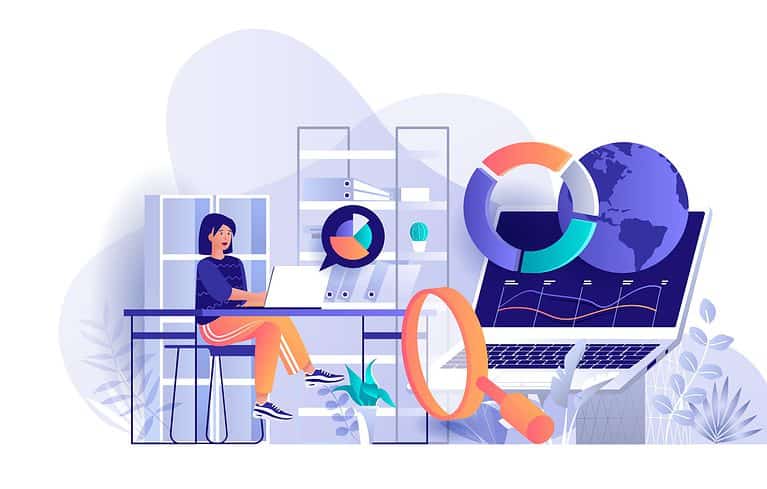Essential Guide to Transform Business in the AI Revolution: Thrive in the New Era
The proliferation of Artificial Intelligence (AI) has triggered a revolution around the world, altering how we conduct our lives, careers and engagements. This development is comparable to earlier industrial revolutions in its magnitude. With AI standing as an influential factor enabling prolific growth and creativity within various sectors. Thus, it is fundamental that businesses secure themselves a “guide for adaptation during this time of AI transformation” so they can exist successfully amidst these changes.
Key Takeaways
The Fourth Industrial Revolution, powered by AI, is transforming industries by streamlining supply chains, enhancing customer experiences, and driving rapid economic change with successful adopters potentially seeing a 122% positive cash flow change by 2025.
Key technologies within AI include Machine Learning, Natural Language Processing, and Robotics and Automation, contributing towards intelligent, autonomous systems that enable significant organizational efficiencies and improved human-machine interactions.
For successful transformation in the AI era, businesses must align AI initiatives with strategic goals, upskill and reskill their workforce, focus on building a data-centric organization, and proactively address ethical and regulatory challenges.
Embracing AI in Business Transformation

We stand on the precipice of a Fourth Industrial Revolution, an era characterized by the amalgamation and interplay between digital, physical and biological spheres through advanced new technologies. Building on what was established during the Third Industrial Revolution. Artificial Intelligence is being used to pave this current revolution’s way towards progress. The Digital Revolution’s effect has been felt as customers now view their experience with any organization as vital as its actual product or service offerings due to digitization enabled capabilities driving personalized experiences for them like never before. It could be argued that COVID-19 Energized Industry 4.0 technology adoption in order for businesses to stay afloat amidst changes in consumer demand while also streamlining supply chains simultaneously for efficiency gains across industries at large.
Understanding the AI revolution
The Fourth Industrial Revolution, which has been mentioned by the World Economic Forum as having a remarkable scope and pace of development to previous industrial revolutions, is largely driven by Artificial Intelligence (AI). It began with mass production coming from the First Industrial Revolution. This so-called Industry 4.0 will bring about substantial economic growth due to advanced technologies that AI enables. It can potentially yield cash flow changes of 122% up until 2025 for companies at its forefront. Quantum computing holds great promise for Revolutionizing this field because it increases computational power beyond what was thought possible before now allowing intricate data models creation on an expedited timeline.
Identifying opportunities for AI implementation
Businesses must identify opportunities to introduce AI in order to remain competitive. Industry 4.0 technologies optimize efficiency, reducing transportation and communication costs through limiting waste production. AI can enhance supply chain management by making processes smoother as well as boosting communications within the firm for a more efficient workflow without extra spending.
Augmented reality applications enable businesses to cross the divide between digital & physical worlds, allowing them access data from both realms with Cyber Physical Systems while still providing customers amazing experiences.
Key Technologies Driving the AI Revolution

The AI revolution is enabled by a range of technologies, particularly Machine Learning, Natural Language Processing and Robotics and Automation. These advances are creating intelligent systems that will significantly affect various sectors. In particular, machine learning forms an essential aspect of this development as it allows computers to learn from data without explicit coding instructions. While NLP makes possible more natural human-computer communication through interpretation capabilities. Together these innovations are responsible for the current paradigm shift in automation and efficiency we now experience across industries today.
Machine Learning
Machine learning is an essential component of modern Artificial Intelligence as it allows for computers to become increasingly adaptive. This technology relies on different algorithms, such as Nearest Neighbor, Naive Bayes and Decision Trees, which can identify patterns in data. Other popular techniques include Linear Regression and Logistic Regression. They are divided into three distinct categories – supervised learning, unsupervised learning or reinforcement learning. To ensure the highest accuracy when developing machine-learning models, there are several validation procedures like Training-validation split, K-fold cross-validation, Stratified k fold cross validation Leave one out Cross Validation and Bootstrapping. These methods guarantee optimal efficiency by helping machines learn from their mistakes, making them smarter with each iteration.
Natural Language Processing
The use of Natural Language Processing (NLP) has become fundamental in the development and growth of Artificial Intelligence. This technology works by carrying out a range of calculations such as tokenization, syntactic analysis, semantic evaluation and machine learning to recognize sentence structures meaningfully while completing activities like sentiment examination, interpretation and information extraction.
In business operations, there are numerous applications for NLP including document grouping, conversation agents providing customer service solutions, automatic translation services that eliminate language barriers. Assessment to measure user opinion/perception towards products or topics related to it; and text condensation allowing quick access to critical points within large chunks with data. Applying this can lead companies to make their processes more effective since manual labor is less required thereby reducing cost expenditure at the same time being able to reassign manpower elsewhere necessary priorities.
Robotics and Automation
Robotics and automation are key elements of the AI revolution, advancing businesses by optimizing processes, assigning tasks to personnel more efficiently and cost-effectively, ensuring improved safety levels as well as consistent quality control. Integrating machine learning into robotics has created opportunities for robots to carry out complex activities while gaining knowledge from their encounters.
This technology contributes greatly in enhancing business efficiency due to its ability to prioritize worker responsibilities with accuracy plus lower operational expenses through accurate results every time. It offers better safety protection measures which add an extra layer of security when dealing with sensitive material or hazardous environments thus increasing peace of mind significantly when working within these industries.
Preparing Your Workforce for the AI Revolution

As the Fourth Industrial Revolution has the capability to disrupt labor markets, companies need to ensure their staffs are well-equipped with upskilling and reskilling for a successful transition. For this purpose, employees should concentrate on building digital literacy, adaptability and problem solving skills that would be necessary in AI powered environments which necessitate quick adaptation from businesses. Cultivating such attributes is crucial if we wish to gain an advantage during this industrial revolution disrupting current labor markets.
Upskilling and reskilling employees
Upskilling encompasses developing employees’ skillsets to keep their current roles up-to-date as industry skill sets evolve. Having a successful AI strategy hinges on having the right talent with desired abilities, while also making sure that this artificial intelligence is utilized properly and allocating sufficient resources in change management. If these criteria are not met, then strategic alignment may be lacking alongside diminished expertise within an organization coupled by insufficient data quality which can halt its progress toward success.
Fostering a culture of innovation
Maintaining a culture of innovation is as essential to the workforce’s readiness for AI transformation just like upskilling and reskilling. This type of environment enables organizations to benefit from: talent acquisition, embracing novel approaches into their operations, encouraging creative thinking while advancing learning opportunities with technology evolution. Consequently, staff members are highly encouraged to take part in exploring upcoming technologies. Brainstorm unique ideas whilst developing agility which aids effectively utilizing Artificial Intelligence capabilities. This kind of open conversation enhances customer experience without the need for human assistance even further.
Developing an AI-Driven Business Strategy

In order to build an AI-driven business strategy, it is important to tie initiatives with the desired outcomes of a company. To do this, steps need to be taken such as defining objectives and values, understanding present capabilities, recognizing possibilities that fit in line with goals, crafting implementation plans for those ideas, creating the infrastructure needed and monitoring results. Data plays a key role throughout by providing data points necessary for informed decision making processes along with optimizing automation systems through swift delivery capabilities which all support optimal decisions when proceeding ahead.
Aligning AI initiatives with business goals
It is critical that AI initiatives are in tune with business goals, so as to guarantee a positive outcome from the investment and drive success for an organization. Failure to do this can bring about various problems, such as unaligned strategies, inadequate knowledge sets or reluctance towards using AI. Plus, issues regarding data quality combined with disregarding change management necessities may come into play too. It’s important skills are adequate and internal capabilities sufficiently developed if organizations wish their use of Artificial Intelligence investments generate tangible results over time.
Building a data-driven organization
To become a data-centric organization requires embracing the utilization of data as an essential resource and building capabilities to leverage it for more enlightened decisions and operational effectiveness. The right infrastructure is significant in such enterprises because it enables handling large amounts of information, centralizes safekeeping, and provides facilities related with creating, managing, and utilizing securely all this content.
So that organizations may transition smoothly to this new pattern, they must: create consistency regarding flowing datasets, cultivate practices focused on collecting relevant analytics, exploit advantages like improved reporting speediness or granting access to trustworthy knowledge easily.
Navigating Ethical and Regulatory Challenges

Ensuring that AI can be ethically and legally implemented requires significant attention to safeguarding data privacy and security, reducing the presence of bias in algorithmic systems, as well as being mindful of potential issues such as inconclusive evidence or unequal outcomes. Companies should take steps like introducing strict cybersecurity measures, utilizing anonymization methods for personal data protection or incorporating differential privacy approaches. There are ethical considerations related to surveillance concerns, biases based on discrimination factors along with transparency accountability questions which need answers too.
Ensuring data privacy and security
Robust security measures, a governance framework and anonymization tactics must be implemented to strengthen data privacy protections in AI systems. This is reflected by the GDPR requiring that preventive steps for safeguarding private info are taken from the design period and through its life-cycle. Not ensuring such measures can result in unfair decisions being made, as well as increased risks of unauthorized access to personal information which could perpetuate bias or even lead to breaches of data protection regulations.
Addressing bias and fairness in AI systems
AI bias can result from incorrect assumptions or data sets with an unbalanced representation. Techniques such as utilizing balanced training datasets and including metrics against labels are necessary to minimize this issue. To guarantee equitable AI systems, regulations must be established regarding how personal information is managed, providing technical advice on impartiality concerning protected characteristics and preventing discrimination of any kind should also play a role in the process.
Case Studies: Successful AI Transformations
The AI revolution, a reality already affecting many businesses from various sectors, can be observed through the deployment of robots at Lowe’s to locate items and Walgreens’ utilization for an array of tasks as well as its incorporation in retail and e-commerce. For companies looking to adopt this technology effectively, it is important to start with ambitious visions while also ensuring realistic planning and allocating adequate resources.
This wisdom acquired by early adopters could ultimately lead other organizations that want or are needing innovative solutions towards success when leveraging AI into their operations.
Industry-specific applications
In the medical industry, AI is helping to reduce mundane administrative work, providing assistance in research and aiding public health initiatives. It also powers surgical robots that enable surgeons to be more precise during operations.
Manufacturing sector has been greatly benefited by AI which accurately detects malfunctioning equipment or predicts potential failures while improving product quality through analytics thereby eliminating defective units. It assists with supply chain management as well. Its uses have extended into agriculture, such as automated identification of pests/diseases in plants and advanced sorting techniques for produce plus precision farming approaches for plant disease detection.
Lessons learned
The introduction of AI can bring immense advantages, but it is not without its difficulties. Common issues that arise when introducing Artificial Intelligence into an organization are indistinct goals, lack of change management strategy and the possibility to end up with outputs based on biased data. Nevertheless, looking at companies who have successfully integrated AI such as Tesla, Alibaba and Amazon, we can draw certain conclusions which will help us in our process: prioritizing quality and availability of information, organizing processes methodically creating a reliable framework, and channeling efforts towards resolving explicit commercial problems for maximum gain from deploying AI technology.
Summary
To successfully adapt to the AI revolution, businesses must incorporate new technologies and align their objectives with these advances. It’s also critical that companies address ethical concerns such as data privacy, security measures, bias and fairness within the applications. By leveraging best practices from successful transformations across industries for guidance on navigating this journey effectively, they can be sure of success in this transformative era.
Frequently Asked Questions
How to use AI to transform your business?
AI is enabling businesses to boost their efficiency, productivity and target more complex operations. Its data analysis abilities combined with automated administrative processes and enhanced customer service offer a transformation in how companies operate day-to-day.
How do I prepare myself for AI revolution?
To stay ahead of the AI revolution, upgrade your knowledge by honing language and math abilities as well as interpersonal skills. It’s critical to learn how this tech development will personally affect you so that you can proactively adjust accordingly.
What is the significance of AI in the Fourth Industrial Revolution?
The Fourth Industrial Revolution, with its integration of AI in cyber-physical systems and computers, has the potential to dramatically affect our lives professionally as well as personally.
What are the ethical and regulatory challenges in the AI revolution?
The AI revolution demands attention to ethical and regulatory matters such as data privacy, system fairness and mitigating bias. These considerations are key components in the responsible implementation of artificial intelligence systems. In order to protect all parties involved, it is essential for developers to keep these factors front-and-center when crafting this technology.






